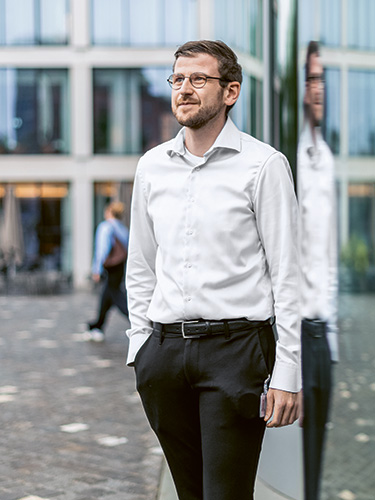A leap from science to industry.
Interview: Céline Emch
How does a nanoscientist end up in the insurance industry? Marco Krummenacher talks to us about how he launched his postresearch career.
AlumniBasel: Dr. Krummenacher, what drove you to study nanosciences?
Marco Krummenacher: Back in school, I was fascinated by the natural sciences, but I didn’t want to tie myself down to a single subject. The nanoscience program at Basel University offered the ideal mix of physics, chemistry, mathematics and biology. I was particularly attracted by the theoretical part of physics and so I chose physics as my specialization in the master’s program, before going on to do my doctorate in computational physics.
How did you end up working in insurance?
After 10 years of research, I was looking for a new challenge outside of academia. And the alumni mentoring program provided ideal support here. Not only did it allow me insights into various professions, but the personal advice from my mentor gave me the self-confidence I needed to launch my career. We discussed everything from professional appearance and salary negotiations to attending interviews, which we even practiced in role plays.
What did you find particularly helpful about this process?
My mentor helped me translate my academic strengths into a business context. As people are rarely looking specifically for a “physicist,” he encouraged me to explore new avenues. That was how I stumbled across the insurance industry, which — like physics — relies heavily on mathematical models. One key moment was a presentation by Baloise as part of the alumni mentoring, where I not only got to know the company but also learned about the vacancy for a quantitative developer, which I’m delighted to have filled.
What exactly does your work entail?
With my five-person team, I develop actuarial software at Baloise — that is, the software for assessing risks and financial uncertainties. This helps staff at the insurance company when it comes to key calculations in business transactions. They use the software not only to assess portfolios and the associated risk by calculating the probability of accidents, illnesses or natural disasters, but also to plan reserves for crises and evaluate large volumes of data with a view to spotting trends such as a change in life expectancy at an early stage.
Does that mean your work is done once the software is up and running?
A piece of software is never finished. New requirements emerge on an ongoing basis — faster processes, new products or changes to the model. For this, we work closely with the actuarial team that specifies the guidelines, resulting in a fascinating interface between software development and actuarial theory. With this interdisciplinary collaboration and the mix of well-known and innovative technologies, I find my job particularly varied and appealing. There’s never a dull moment!
Marco Krummenacher’s tips for getting started in a career:
1. Dare to explore new horizons! Your course of studies needn’t define your entire professional life. Sometimes doors open that you would never have expected, so keep an open mind.
2. Apply for jobs you’re genuinely interested in — even if you don’t meet all the requirements. Look for something you find fulfilling, because work is meant to be fun! Moreover, companies often value motivation and willingness to learn over a perfect match.
3. Look for opportunities to exchange ideas: Take advantage of programs such as alumni mentoring, talk to graduates and learn from their experiences — this opens up valuable new perspectives.
More articles in this issue of UNI NOVA (November 2025).

